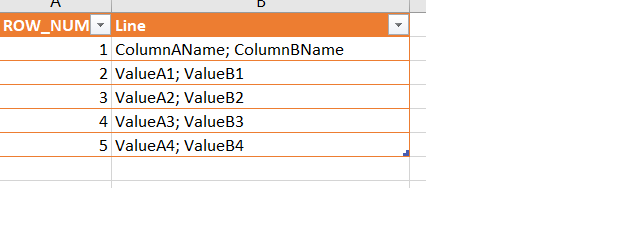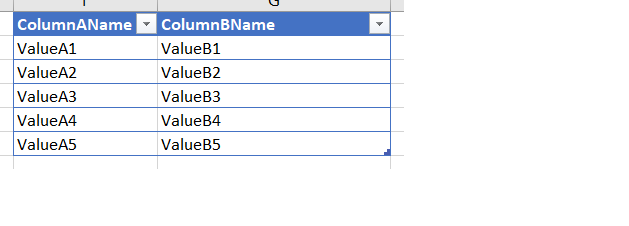TSQL: How to transform first row as column name?
-
May 2, 2019 at 6:29 pm
Hello,
I hope you are all well.
I would like your help on a data transformation task that I have.
I would like to convert the first row of a table to a column name
I am working on SQL Server Azure and I get daily data from another service.This service loads a table that is of the same form:

I would like to transform the data in the same manner:

Do You have any idea how to do it ?
Thank you for your help
-
May 2, 2019 at 6:34 pm
Do the column names change from day to day?
If they do, do you want to create a new table every day?
Or is the target table static in structure such that you just want to ignore row 1 and split rows 2 and beyond before loading them?
The absence of evidence is not evidence of absence
- Martin Rees
The absence of consumable DDL, sample data and desired results is, however, evidence of the absence of my response
- Phil Parkin -
May 2, 2019 at 6:45 pm
Your data looks like a odd mix of an excel file and a CSV. If you were sticking to one technology this would actually be easier. Phil raises some good questions here though. I'd hate for this to have to go down the dynamic-SQL route.
Also, cross post on Stack Overflow: https://stackoverflow.com/questions/55958126/how-to-transform-first-row-as-column-name
Thom~
Excuse my typos and sometimes awful grammar. My fingers work faster than my brain does.
Larnu.uk -
May 2, 2019 at 7:37 pm
Also, how do you get this data?
-
May 2, 2019 at 9:07 pm
Hello,
Data are in a sql Server table.
I used excel just for illustrate my issue.
-
May 2, 2019 at 9:10 pm
Data are loaded every night by an ETL from another service.
-
May 2, 2019 at 9:15 pm
Lidou123 wrote:Hello, Data are in a sql Server table. I used excel just for illustrate my issue.
So the data is stored in a delimited format in your Table? This sounds like the problem is your ETL process and you need to fix that. The ETL process should be creating the appropriate table, with the right column names, and storing the right values in the right column. Not storing colon delimited data in the table without the correct column headings.
You need to share the details of your ETL package and then we can explain how to fix it.
Thom~
Excuse my typos and sometimes awful grammar. My fingers work faster than my brain does.
Larnu.uk -
May 2, 2019 at 9:51 pm
Lidou123 wrote:Hello Phil Thanks for your answers. - We have 50 tables that could be refreshed. Depending of the day, we receive data for a specific destination table. So column name could change from day to day.
So am I right in thinking that you determine which table is the target based on the column names? That is, you have some sort of mapping rules?
The absence of evidence is not evidence of absence
- Martin Rees
The absence of consumable DDL, sample data and desired results is, however, evidence of the absence of my response
- Phil Parkin -
May 3, 2019 at 2:55 am
Also, does the row number get populated? Without that, you can't tell where the columns are. Rows have no natural order.
This can probably be done in T-SQL, though how do you know what the target table is? It would be helpful if you mocked your table in SQL Server with some data, then show how you want results, with table and column names.
-
May 3, 2019 at 3:12 am
Hello Phil.
Thank you for your answers.
I will be able to clarify my request.
The rules and process for the loading datadata like that:
- we receive an email from another service that warns us that they will refresh the data from table A.
Table A has 3 columns.
Column1 -> Row Num
Column2-> Destination Table (Table B)
Column3 -> data (with first is column name)
The first row is the name of column and then we have data associated to these columns.
The first row is like the mapping schema for my destination table.
Separator field is always the same (semicolumn).
- Then I need to load data from Table A to table B. Table B is already created and is static ( columns don't change).
I am trying to develop a Dynamic query with a parameter table for the insert script. But I don't know if It's the best solution.
Thank you for your help.
-
May 3, 2019 at 8:16 am
So, assuming I understand correctly, your data looks like this:
CREATE TABLE dbo.ETLData (ROW_NUM int,
Line varchar(255)); --Guessed data type
INSERT INTO dbo.ETLData (ROW_NUM,
Line)
VALUES(1,'ColumnAName;ColumnBName'),
(2,'ValueA1;ValueB1'),
(3,'ValueA2;ValueB2'),
(4,'ValueA3;ValueB3'),
(5,'ValueA4;ValueB4');Couple of methods here involve Dynamic SQL. The first uses
PARSENAME, assumes that each column will have a string length of 128 characters or less, and that there are only 2 (although you can expand this method up to 4). It will not scale automatically and means your data can't include a period(.) either:DECLARE @SQL nvarchar(MAX);
SELECT @SQL = N'SELECT ROW_NUMBER() OVER (ORDER BY ED.ROW_NUM) AS RN,' + NCHAR(13) + NCHAR(10) +
N' D.PN2 AS ' + QUOTENAME(C.PN2) + N',' + NCHAR(13) + NCHAR(10) +
N' D.PN1 AS ' + QUOTENAME(C.PN1) + N'' + NCHAR(13) + NCHAR(10) +
N'FROM ETLData ED' + NCHAR(13) + NCHAR(10) +
N' CROSS APPLY(VALUES(PARSENAME(REPLACE(Line,'';'',''.''),1),PARSENAME(REPLACE(Line,'';'',''.''),2))) D(PN1,PN2)' + NCHAR(13) + NCHAR(10) +
N'WHERE ED.ROW_NUM > 1;'
FROM dbo.ETLData ED
CROSS APPLY(VALUES(PARSENAME(REPLACE(Line,';','.'),1),PARSENAME(REPLACE(Line,';','.'),2))) C(PN1,PN2)
WHERE ED.ROW_NUM =1 ;
PRINT @SQL;
EXEC sp_executesql @SQL;If you need a solution that automatically handles varying data (different column amounts) or more than 4, you need to be a bit more "clever". This uses Jeff Moden and Eirikur Eiriksson's work on delimitedsplit8k_lead. I'm not using STRING_SPLIT, as it doesn't provide ordinal position, and so can't be relied on. Note that if Line can have more than 8,000 characters (or 4,000 if you need to use N4K version) then this will truncate the value. Hopefully that isn't the case (if it it, I refer to my closing comment).
DECLARE @SQL nvarchar(MAX);
SELECT @SQL = N'SELECT ROW_NUMBER() OVER (ORDER BY ED.Line) AS RN,' + NCHAR(13) + NCHAR(10) +
STUFF((SELECT ',' + NCHAR(13) + NCHAR(10) +
N' MAX(CASE WHEN DS.ItemNumber = ' + CONVERT(varchar(4),DS.ItemNumber) + N' THEN DS.Item END) AS ' + QUOTENAME(DS.Item)
FROM dbo.ETLData ED
CROSS APPLY dbo.DelimitedSplit8K_lead(ED.Line,';') DS
WHERE ED.ROW_NUM = 1
ORDER BY DS.ItemNumber
FOR XML PATH(N''),TYPE).value('.','nvarchar(MAX)'),1,3,N'') + NCHAR(13) + NCHAR(10) +
N'FROM ETLData ED' + NCHAR(13) + NCHAR(10) +
N' CROSS APPLY dbo.DelimitedSplit8K_lead(ED.line,'';'') DS' + NCHAR(13) + NCHAR(10) +
N'WHERE ED.ROW_NUM > 1' + NCHAR(13) + NCHAR(10) +
N'GROUP BY ED.Line' + NCHAR(13) + NCHAR(10) +
N'ORDER BY ED.Line;';
PRINT @SQL;
EXEC sp_executesql @SQL;If you need to, you can make either of these dynamic statements into an INSERT statement; the PRINT statement will help you debug the queries.
Honestly, I still think the better place to do this is change the ETL process to properly import the data though, and not importing delimited data. Unfortunately without knowing the process you're using, it'll be very hard to tell you how to fix it.
- This reply was modified 5 years, 6 months ago by Steve Jones - SSC Editor. Reason: Formatting
Thom~
Excuse my typos and sometimes awful grammar. My fingers work faster than my brain does.
Larnu.uk -
May 3, 2019 at 8:19 am
Thank you Thom A for your answer
I will test it in this morning
-
May 3, 2019 at 8:42 am
Ahh, if that's the format and requirement, then this is a more "complete" solution (assumes that the ID column will always be called
Id) that inserts the data into the appropriate table defined by the columnsas_table:CREATE TABLE dbo.ETLData (ROW_NUM int,
Sas_table sysname,
Line varchar(255)); --Guessed data type
INSERT INTO dbo.ETLData (ROW_NUM,
Sas_table,
Line)
VALUES(1,'dbo.SampleTable','ColumnAName;ColumnBName'),
(2,'dbo.SampleTable','ValueA1;ValueB1'),
(3,'dbo.SampleTable','ValueA2;ValueB2'),
(4,'dbo.SampleTable','ValueA3;ValueB3'),
(5,'dbo.SampleTable','ValueA4;ValueB4');
CREATE TABLE dbo.SampleTable (ID int,
ColumnAName varchar(50),
ColumnBName varchar(50));
GO
DECLARE @SQL nvarchar(MAX);
SELECT @SQL = N'INSERT INTO ' + CONCAT_WS('.',QUOTENAME(PARSENAME(ED.Sas_table,4)),QUOTENAME(PARSENAME(ED.Sas_table,3)),QUOTENAME(PARSENAME(ED.Sas_table,2)),QUOTENAME(PARSENAME(ED.Sas_table,1))) + NCHAR(13) + NCHAR(10) +
N' ([Id],' + STUFF((SELECT ',' + QUOTENAME(DS.Item)
FROM dbo.DelimitedSplit8K_LEAD(ED.Line,';') DS
WHERE ED.ROW_NUM = 1
ORDER BY DS.ItemNumber
FOR XML PATH(''),TYPE).value('.','nvarchar(MAX)'),1,1,N'') + ')' + NCHAR(13) + NCHAR(10) +
N'SELECT ROW_NUMBER() OVER (ORDER BY ED.Line) AS RN,' + NCHAR(13) + NCHAR(10) +
STUFF((SELECT ',' + NCHAR(13) + NCHAR(10) +
N' MAX(CASE WHEN DS.ItemNumber = ' + CONVERT(varchar(4),DS.ItemNumber) + N' THEN DS.Item END) AS ' + QUOTENAME(DS.Item)
FROM dbo.ETLData ED
CROSS APPLY dbo.DelimitedSplit8K_LEAD(ED.Line,';') DS
WHERE ED.ROW_NUM = 1
ORDER BY DS.ItemNumber
FOR XML PATH(N''),TYPE).value('.','nvarchar(MAX)'),1,3,N'') + NCHAR(13) + NCHAR(10) +
N'FROM ETLData ED' + NCHAR(13) + NCHAR(10) +
N' CROSS APPLY dbo.DelimitedSplit8K_LEAD(ED.line,'';'') DS' + NCHAR(13) + NCHAR(10) +
N'WHERE ED.ROW_NUM > 1' + NCHAR(13) + NCHAR(10) +
N'GROUP BY ED.Line' + NCHAR(13) + NCHAR(10) +
N'ORDER BY ED.Line;'
FROM dbo.ETLData ED
WHERE ED.ROW_NUM = 1;
PRINT @SQL;
EXEC sp_executesql @SQL;
GO
SELECT *
FROM dbo.SampleTable;
GO
DROP TABLE dbo.ETLData;
DROP TABLE dbo.SampleTable;Considering you're using SQL Server 2017, you could use
STRING_AGG, but I don't get to use my 2017 Sandbox often, and not everyone does have access to the function; hence I tend to stick toFOR XML PATHandSTUFF. This would more succinct usingSTRING_AGGand you might as well use the functionality you've got considering your on the latest version (I did remember to useCONCAT_WSat least, which was a nice addition in 2017).- This reply was modified 5 years, 6 months ago by Thom A. Reason: Cause if my indents aren't right it annoys me. :)
Thom~
Excuse my typos and sometimes awful grammar. My fingers work faster than my brain does.
Larnu.uk
Viewing 15 posts - 1 through 14 (of 14 total)
You must be logged in to reply to this topic. Login to reply



